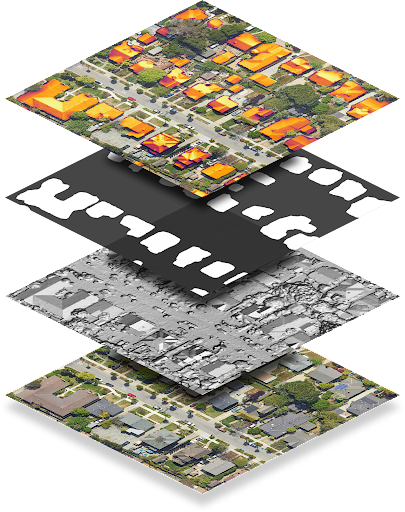
Punkt końcowy dataLayers zwraca dane zakodowane jako pliki GeoTIFF, które można wykorzystać w dowolnej aplikacji systemu informacji geograficznej (GIS) do projektowania systemów solarnych.
Każdy ciąg znaków w odpowiedzi dataLayers zawiera adres URL, którego możesz użyć do pobrania odpowiedniego pliku GeoTIFF. Adresy URL są ważne przez maksymalnie godzinę od momentu wygenerowania ich na podstawie pierwotnego żądania warstw danych. Pliki GeoTIFF mogą być przechowywane przez maksymalnie 30 dni.
Z wyjątkiem warstwy RGB pliki GeoTIFF nie są prawidłowo wyświetlane w przeglądarce obrazów, ponieważ zawierają zakodowane dane, a nie obrazy RGB. Plików GeoTIFF nie można też używać bezpośrednio jako obrazu nakładki w interfejsie Maps JavaScript API.
Poniższa tabela zawiera szczegółowy opis każdej warstwy.
| Warstwa | Głębia piksela | Rozdzielczość | Opis |
|---|---|---|---|
| Cyfrowy model powierzchni (DSM) | Liczba zmiennoprzecinkowa 32-bitowa | 0,1 m/piksel | Dane o wysokości, które przedstawiają topografię powierzchni Ziemi, w tym elementy naturalne i stworzone przez człowieka. Wartości są podawane w metrach nad poziomem morza. Nieprawidłowe lokalizacje lub obszary, dla których nie mamy danych, są przechowywane jako -9999. |
| RGB | 8-bitowa | 0,1 m/piksel 0,25 m/piksel |
Zdjęcie lotnicze lub satelitarne regionu. Plik obrazu GeoTIFF zawiera 3 pasma odpowiadające wartościom czerwonym, zielonym i niebieskim, które tworzą 24-bitową wartość RGB dla każdego piksela. Domyślna rozdzielczość piksela to 0,1 m/piksel. |
| Maska budynku | 1-bitowy | 0,1 m/piksel | Jeden bit na piksel wskazujący, czy dany piksel jest uznawany za część dachu. |
| Roczny strumień | Liczba zmiennoprzecinkowa 32-bitowa | 0,1 m/piksel | Mapa rocznego strumienia energii słonecznej lub rocznego nasłonecznienia dachów w regionie.
Wartości są podawane w kWh/kW/rok. Wartość strumienia jest obliczana dla każdej lokalizacji, a nie tylko dla dachów budynków. Nieprawidłowe lokalizacje lub obszary, w których nie udało się obliczyć strumienia, są przechowywane jako -9999. Lokalizacje poza naszym obszarem objętym usługą są nieprawidłowe. Uwaga: jest to strumień bez maskowania. |
| Miesięczny strumień | Liczba zmiennoprzecinkowa 32-bitowa | 0,5 m/piksel | Miesięczna mapa strumienia (światło słoneczne padające na dachy, podzielone według miesięcy) w regionie. Wartości są podawane w kWh/kW/rok. Plik obrazu GeoTIFF zawiera 12 pasów odpowiadających kolejno miesiącom od stycznia do grudnia. |
| Cień co godzinę | Liczba całkowita 32-bitowa | 1 m/piksel | 12 adresów URL godzinowych map cieni odpowiadających okresowi od stycznia do grudnia w odpowiedniej kolejności. Każdy plik GeoTIFF zawiera 24 pasma odpowiadające 24 godzinom doby. Każdy piksel to 32-bitowa liczba całkowita odpowiadająca (maksymalnie) 31 dniom danego miesiąca. Wartość 1 bit oznacza, że w danym dniu, o danej godzinie i w danym miesiącu w odpowiednim miejscu widać słońce. Nieprawidłowe lokalizacje są przechowywane jako -9999 i mają ustawiony bit 31, ponieważ odpowiada to 32 dniowi miesiąca, a więc jest nieprawidłowe. |
Dekodowanie rastrów cienia godzinowego
Dane dotyczące zacienienia w poszczególnych godzinach są kodowane w rastrach wielopasmowych. Więcej informacji o podstawach rastrów znajdziesz w sekcji Pojęcia związane z interfejsem Solar API.
Gdy poprosisz o godzinowe dane dotyczące zacienienia, możesz otrzymać maksymalnie 12 rastrów – po jednym na każdy miesiąc roku kalendarzowego (od stycznia do grudnia). Każdy raster składa się z 24 warstw, czyli pasm, które odpowiadają 24 godzinom doby.
Każde pasmo jest reprezentowane przez macierz komórek, czyli pikseli. Każdy piksel ma głębię 32 bitów, co odpowiada (maksymalnie) 31 dniom miesiąca. Dekodowanie danych dotyczących cienia w określonym dniu, czasie i miesiącu wymaga zatem zrozumienia analizowanego bitu, pasma i rastra.
Aby na przykład sprawdzić, czy w danej lokalizacji o współrzędnych (x, y) 22 czerwca o godzinie 16:00 świeciło słońce, wykonaj te czynności:
- Wysyłanie żądania dotyczącego warstw danych dla wszystkich warstw w lokalizacji (x, y).
- Ponieważ czerwiec jest szóstym miesiącem roku, pobierz szósty adres URL z listy
hourlyShadeUrls. - Przedziały godzinowe są podawane w formacie 24-godzinnym. Aby uzyskać dane z godziny 16:00, wyszukaj 17 kanał.
- Indeks bitów (dni) od 0. Aby uzyskać dane z 22 czerwca, odczytaj bit 21.
- Bity zawierają dane binarne wskazujące, czy w danym miejscu w określonym dniu i o określonej godzinie było słońce. Jeśli bit ma wartość 1, oznacza to, że w danym miejscu było słońce. Jeśli bit ma wartość 0, w tej lokalizacji było zacienienie.
Poniższy kod podsumowuje powyższe kroki:
(hourly_shade[month - 1])(x, y)[hour] & (1 << (day - 1))

